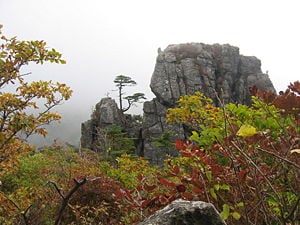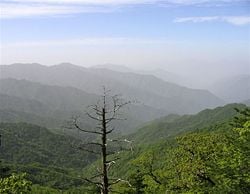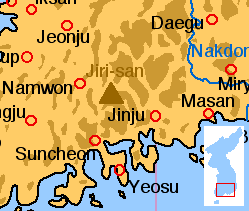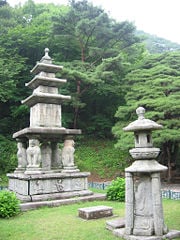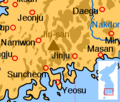Jirisan
Jirisan (지리산, 智異山) is a mountain in the southern part of South Korea. It is often referred to as one of the three mountains of the gods, along with Hallasan and Kǔmgangsan. Jirisan National Park, which surrounds Jirisan, with an area of 471.75 km² that spans three provinces: North and South Jeolla and South Gyeongsang, is South Korea's largest and oldest, having been designated a National Park in 1967. South Gyeongsang province contains the largest portion of the park.
Jirisan's names
The 'ji' in the name of Jirisan or Mt. Jiri is the chinese character for wisdom, and it is said that even an ignorant man can become wise by staying on Jirisan. The mountain is sometimes called Duryusan, referring to the spirit of Mt. Baekdu (White-head) which is felt to flow down the back of the Baekdudaegan mountain range all the way from the China-Korea border to Jirisan. Another name for the mountain is Bangjangsan, which means 'dwelling place of esteemed monks'.
Jirisan's peaks
Jirisan's highest peak, Cheonwangbong (천왕봉, 天王峰), which means King of Heaven Peak, rises to 1,915 meters above sea level, making it South Korea's second highest peak, after Hallasan (1,950 m), Jeonwangbong is surrounded by many other peaks over 1000 meters, including Jeseokbong (1,806 m), Banyabong (1,732 m) and Nogodan peak (1,507 m), creating a view that looks like a sea of mountains continuing off into the distance. Another well-known peak is Samshin-bong (Three Spirits Peak).
Jirisan is also considered one of the three most important mountains in South Korea, with Hallasan and Seoraksan being the other two. It is located at the southern end of the Sobaek mountain range (the Small White Mountains), and therefore also the southern end of the Baekdudaegan mountain range, the "spine" of the Korean Peninsula which incorporates the Sobaek mountain range and most of the Taebaek mountain range (the Great White Mountains).
Historical sites near Jirisan
Jirisan is located near three important Korean cities.
Jirisan's Temples
Hwaeomsa Temple, the largest and best-known among the seven major Buddhist temples on Jirisan, contains many precious cultural assets, including four national treasures, primarily mostly stone artworks from about 600-900 C.E. Gakhwangjoen (National Treasure no. 67), named by King Sukjong, is a three-story stone pagoda propping up four lions. Also notable is the Gakwhangjoen seokdeung, one of the largest stone lanterns in existence. In addition, the temple houses six other registered treasures including Daeungjeon, the Dongseo five-story stone pagoda, Wontongjoen, and Hwaeomseokgyeong.
One of Korea's ten most famous temples, Hwaeomsa is situated near Jirisan's Nogodan peak. The great Buddhist priest, Yeongidaesa, built this historical temple, named for the Buddhist scripture Hwaeomkyeong, starting in the fifth year of the reign of King Jinheung of Silla (544 C.E.), a few centuries after the introduction of Buddhism to Korea. Destroyed during the Japanese invasion near the end of the 16th century, restoration of the temple was taken on by Byeokamseonsa, an esteemed priest, during the 8th year of the reign of King Injo of Joseon (1630). In its early days, Hwaeomsa was the head temple for the Hwaeom sect of Buddhism, and is now one of 12 district head temples for the Jogye Order of Buddhism, the largest division of Korean Buddhism today
Sanggyesa Temple. This old temple located in the middle of southern Jirisan was built by the esteemed priest Jingamseonsa on his return from the Dang Dynasty during the 2nd year (840) of King Munseong's reign about 1,100 years ago. It was then destroyed by Japanese invasion but rebuilt by Jingamseonsa together with Songgwangsa and Hwaeomsa.
There are many valuable cultural assets inside the temple. One such treasure is Jingamseonsa-daegongtapbi (National Treasure no. 47) which was written by Choi Chiwon, a great writer in Silla. There is also a five-story stone pagoda, Iljumun, as well as Palsangjoen, and Maaeyerae-jwasang. Not far from the temple, is the beautiful Buril waterfall.
Yeonggoksa Temple Daewonsa Temple Silsangsa Temple
Other features
Jirisan also contains 6 major valleys including Baemsagol and Chilseongyegok valleys, and many waterfalls, among which Guryongpokpo (Nine Dragon Falls), Burilpokpo, Yongchupokpo and Deungseongpokpo are the most spectacular. , The mountain is also home to the Cheonghak-dong (Azure Crane Village) alpine valley, which includes the Samseong-gung (Three Sages Palace), which is a recently-developed site to celebrate one of Korea's foundation myths.
Hwaeomsa, the signature location of Jirisan, is situated in the middle of Nogodan peak. It is one of the ten most famous temples in Korea . A great Buddhist priest, Yeongidaesa, built this historical temple, named after Hwaeomkyeong's (one of the Buddhist scriptures) first two letters, during the reign of King Jinheung, in the fifth year (544) of Silla. Destroyed during the Japanese invasion, the temple was restored by Byeokamseonsa, an esteemed priest, during the reign of King Injo, in the 8th year of Silla(1630). Over the next 25 years, Iljumun, Cheonwangmun, Geumgangmun, Daeungjeon were built, and later on, the esteemed priest, Gyepa, built Wontongjeon and Gakhwangjeon. He therefore, obtained the position of Seongyo Yangjong Daegaram(great temple).
In Hwaeomsa, there are many precious cultural assets. There are four national treasures, including Gakhwangjoen (National Treasure no. 67), which is given its name by King Sukjong, a three-story stone pagoda propping up four lions, and remarkable Gakwhangjoen seokdeung, one of the largest existing stone lights. In addition, there are other six treasures including Daeungjeon, the Dongseo five-story stone pagoda, Wontongjoen, and Hwaeomseokgyeong
Ssanggyesa [Temple]
This old temple located in the middle of southern Jirisan was built by the esteemed priest Jingamseonsa on his return from the Dang Dynasty during the 2nd year (840) of King Munseong's reign about 1,100 years ago. It was then destroyed by Japanese invasion but rebuilt by Jingamseonsa together with Songgwangsa and Hwaeomsa.
There are many valuable cultural assets inside the temple. One such treasure is Jingamseonsa-daegongtapbi (National Treasure no. 47) which was written by Choi Chiwon, a great writer in Silla. There is also a five-story stone pagoda, Iljumun, as well as Palsangjoen, and Maaeyerae-jwasang. Not far from the temple, is the beautiful Buril waterfall.
Naewonsa [Temple]
Naewonsa was built during the period of King Taejong Muyeol and was called Deoksansa during that time. It once prospered with ten small Buddhist temples but was completely destroyed by fire 500 years ago. In 1959 a monk named Houng Wonjong rebuilt the temple and named it Naewonsa.
In Naewonsa, two treasures are left: a three-story stone pagoda, the work of Silla; and 'Seongnamamsu Seokjo Birojana Buljwasang', (stone built statue of Buddha) designated as National Treasure No. 1,021.
Beopgyesa [Temple]
Yeongijosa built this temple at the highest known altitude 1,450 meters in the Korean Buddhism era during the 9th year of King Jinheung (548). It takes two hours to reach the temple on foot.
Along with Korean history, Beopgyesa has had its ups and downs. Its very first ordeal was delivered by Japanese soldiers. Upon their defeat at the hands of General Lee Seonggye the Japanese soldiers set Jirisan on fire as they fled. In 1908, the Japanese delivered the second ordeal and burned it down again, because it was a region renowned for its anti-Japanese protestors. In October of 1948, Jirisan was occupied by a rebel army. A punitive Japanese force was sent to set fire to the region to expel the rebels. This incident became known as the third ordeal. Therefore, there is saying that when Beopgyesa rises, the Japanese fail, and vice versa. In spite of the three sufferings, the temple is rebuilt and an endless line of believers visit the temple of Beopgyesa .
Silsangsa [Temple]
Silsangsa, situated in Sannaemyeon of Namwon at the lower edge of Jirisan, was first opened among the Gusanseonmun of Silla, and considered a temple of defense of the fatherland. Facing the Cheonwangbong peak of Jirisan , it was built by the monk Hongcheok during the 3rd year of King Heungdeok of Silla (828). It was burned to the ground during a great fire in Jeongyujaeran, and subsequently rebuilt 36 buildings during King Sukjong. However, another fire broke in the period of King Gojong, and the area was later restored to normal, albeit in a smaller scale.
Baekjangam, a three-story pagoda, and many other national treasures are left, representing the meaning and dignity of the temple. Starting from Cheonwangbong, the lower edge of the mountain spreads out like a folding screen in front of the temple, embracing it with the merciful heart of Buddha. The crystal clean waters of Banseon Valley originating from Jirisan run along the temple as if washing away the agonies of the world. The leader monk of the nation, Doseon, worried that the essence of the land might have run to Japan through Cheonwang-bong. He therefore put his Japanese map under the floor of Silsangsa Bokwangjeon, and hit it whenever he worshipped in front of Buddha. In so doing, he unwittingly created the saying 'when Silsangsa got excited Japan got ruined'. Within Silsangsa there is one national treasure, eleven treasures, and one local treasure. When looking at Cheonwangmun you can see the highest top of Cheonwangbong at the front.
Yeongwonsa [Temple]
A great Buddhist priest built Yeongwonsa with 100 rooms in nine buildings before it was destroyed by fire. According to legend, a monk named Yeongwon cultivated himself for eight years in a cave. Despite this, he learned nothing and decided to leave. On the way down he saw an old man fishing in the woods. However, there was no water where he was fishing. The old man said to Yeongwon, "I've been fishing here for eight years and I will catch a big fish in two years." He then disappeared. Watching this mysterious scene, Yeongwon decided to return to the cave for two more years. He attained Nirvana and built Yeongwonsa Palace. [1]
- Jirisan Point.jpg
Jirisan Point
Peaks
Samshinbong (bong means 'peak') is 1,284 meters high and a popular, but strenuous, day-hike from the Ssanggye Temple entry point (it is the closest major peak from this trail head). From Ssanggyesa, a trail winds up 2.3km to Buril Falls. From the left turn in the path just before the waterfall, the track continues 6.9km to the peak(for a grand round-trip total of 18.4km). Starting from Ssanggyesa (the sa suffix indicates a Buddhist temple), you can reach the peak in 4 hours at a steady pace. It takes about 3 hours to get down; it's an extremely steep hike. Bring plenty of water as it is not available beyond the temple grounds. Creeks in the vicinity are not safe to drink from without purification or filtering. Giardia lamblia, a water-bourne parasite, is found in South Korean streams, along with other parasites and pathogens.
- Korea-Mountain-Jirisan-12.jpg
- Jirisan in the fall.jpg
- Jirisanfall2.jpg
GETTING THERE
Buses depart regularly from Busan's Seobu Terminal at Sasang for Hadong, the south-eastern entry point into the park. Fare: W9,900
From the Hadong Bus Station, take a bus to Ssanggye-sa. Fare: W2,200
Bus Timetable
Hadong to Ssangyesa 8:00 9:50 10:55 11:40 12:40 13:50 14:50 15:30 16:45 17:30 18:40 20:40
Ssangyesa to Hadong (buy tickets at the restaurant next to the stone bridge leading to Ssangyesa) 7:20 7:45 8:40 9:10 10:00 11:10 12:10 12:40 13:35 14:10 15:20 16:10 17:35
See also
- National parks of South Korea
- List of Korea-related topics
- List of mountains in Korea
- Geography of South Korea
External links
- Jiri-san as a Sacred Mountain, Mason's pages on the religious character and sites of this remarkable set of peaks, slopes and gorges.
Credits
New World Encyclopedia writers and editors rewrote and completed the Wikipedia article in accordance with New World Encyclopedia standards. This article abides by terms of the Creative Commons CC-by-sa 3.0 License (CC-by-sa), which may be used and disseminated with proper attribution. Credit is due under the terms of this license that can reference both the New World Encyclopedia contributors and the selfless volunteer contributors of the Wikimedia Foundation. To cite this article click here for a list of acceptable citing formats.The history of earlier contributions by wikipedians is accessible to researchers here:
The history of this article since it was imported to New World Encyclopedia:
Note: Some restrictions may apply to use of individual images which are separately licensed.
